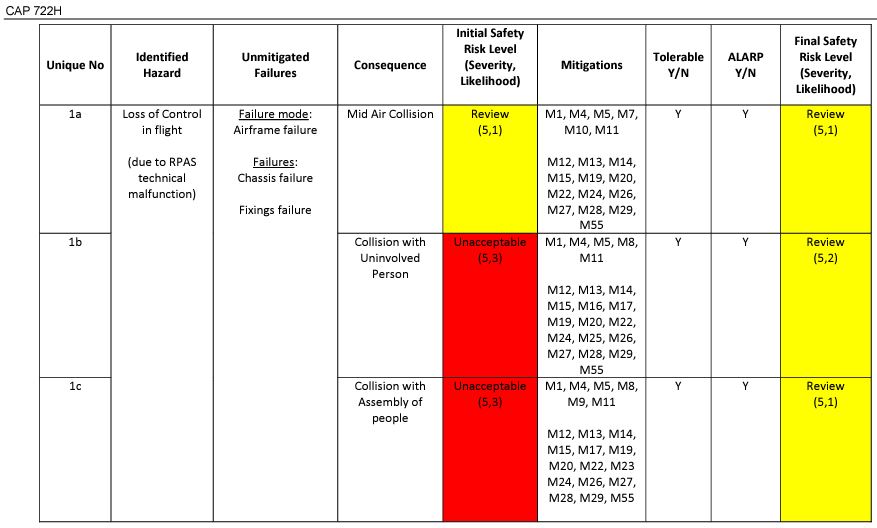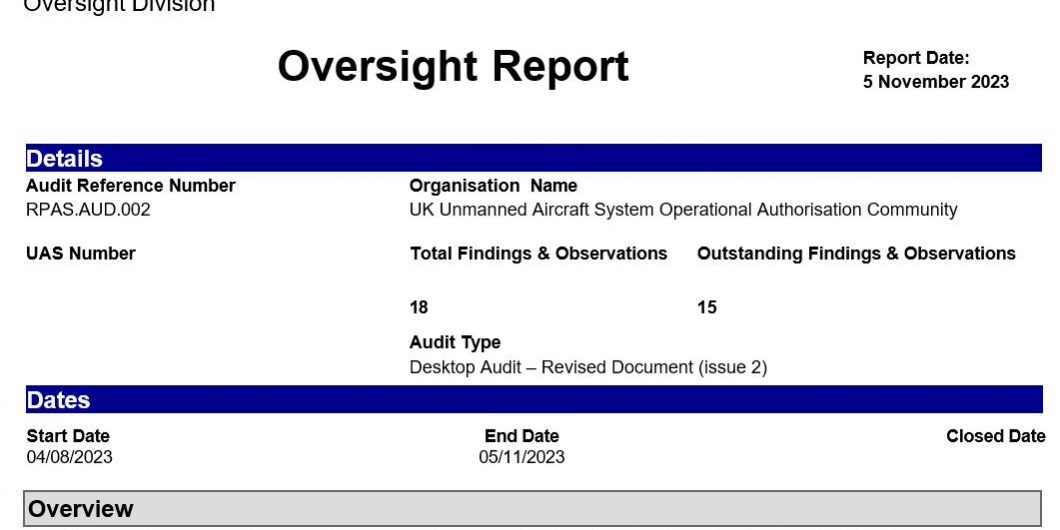Oversight report of CAP 722H version 2
Edit: 14/11/2023 – Oversight report updated . Additional observation.
I’ll start this article with a health warning. Reading it is not for the faint-hearted, particularly if you click on the link to the actual oversight report. The report is necessarily technical in nature and is intended to alert the UK CAA to the problems it has baked in to the latest version of this important document.
If you don’t want to read through the details of CAP 722H but need an operations manual that is compliant with the document, as well as the latest issue of CAP 722A, then Eyeup can help. Just pop along here to read about the Eyeup PDRA01 Gateway.
I will also apologise in advance for any technical errors of my own, typos or misleading and inconsistent content. I feel it is important to get these things in early. Eyeup Aerial Solutions is very serious business but is, by necessity, part-time in nature. Therefore resources are exceedingly small.
I guess I should feel guilty for this, but given the regulator’s approach to errors in safety-critical documentation, perhaps I should cut myself some slack. After all, Mark Wharry (UK CAA RPAS Safety and Oversight Manager) recently explained that the CAA’s systems aren’t actually set up to ensure documentation is correct and that errors are almost bound to creep in. Fortunately, he also undertook to correct documents that don’t make sense.
“We don’t have specialists who purely sit and write documents. We don’t have technical authors and things like that…we don’t have professional authors… It is guys like the ones in my team, the guys and girls there who contribute to the development of those CAPs who are able to provide some of the information or do the direct writing.
It’s a simple fact of the matter that as it gets larger and larger, errors will creep in. We do our best to keep them to a minimum, we encourage entire groups to proof-read. Some people may be more interested in proof-reading the content and actually commenting on how things are phrased we are always going to miss some things unfortunately there.
Concentrate on the content.
If a document doesn’t make sense…that’s not acceptable, we’ve made a mistake and all we can do is try and correct that.“
Mark Wharry – Dronex 2023
Why does version 2 need an Oversight Report?
I was prompted to re-visit the Oversight Report content by another chat at Dronex. It was one where a CAA representative expressed confidence that there would be no further document revisions before the end of 2023. There was no meaningful reply received when I asked “what about a revision to sort out the issues in CAP 722H version 2?”
CAP 722H is the UK CAA’s guidance and policy document covering its Pre-Defined Risk Assessments (PDRA). The document provides the minimum mitigations required to operate against an Operational Authorisation in the Specific Category and actually details what must appear in an operator’s Operations Manual as well as on the Operational Authorisation eventually issued to the operator.
So it has to be properly thought through and correct in all details.
Currently, CAP 722H only contains details of PDRA01. This allows for operations in congested areas at what are considered to be safe clearances from uninvolved people and assemblies of people (or crowds). It is the most basic of authorisations and one that has been in existence in varying forms for many years. The concern is that if the RPAS team can’t understand and risk assess such a well understood (by some) type of operation, then how will it ever be considered safe to expand to more complex operations using this methodology? There are many sources of wisdom on PDRA01 but we know there will be far fewer on whatever more complex PDRAs are to follow.
It is therefore critical that the regulator proves that it has the processes and quality controls in place to correct PDRA01 before it attempts to launch further, more complex risk assessments.
How did Eyeup review version 2?
This was relatively straightforward, though very time consuming. As explained above, the CAP contains a risk assessment. That risk assessment details the mitigations that the regulator expects to see in an operations manual. The document is therefore key to anybody producing a compliant operations manual template… which is something I intended to do.
Part of the issue is turning the “painting by numbers” approach to risk assessment into a meaningful document. This is the time consuming part as it effectively requires a lookup table of the mitigations which are coded into the risk assessment table. Lost yet? Then take a look at the example below
All of those numbered mitigations appear below the end of the full risk assessment and it takes a great deal of effort to make sense of which need to be included in a working risk assessment. Fortunately, this work has been done for you by Eyeup and is available as a practical and fully compliant operations manual.
Using the document for the purpose it was intended is the equivalent of sending a new car around a test track to make sure it can do everything the designers expect. Eyeup has effectively road-tested CAP 722H v2…and found it wanting. Fortunately, as an experienced UAS operator, I am in a position to spot the errors in the document and ensure that they are corrected to the safe and legal side.
Sadly, if you were to mitigate using exactly what is written in the official document, you could find yourself operating outside your Operational Authorisation and therefore the law…despite following the guidance provided that backs the Operational Authorisation.
The Oversight Report.
The full oversight report consists of 8 pages. It is quite detailed and provides a basis for correction of the CAP document. It does not pretend to be a complete and comprehensive correction document. This is because the risk assessment itself is in the gift of the regulator. It is not our place to provide the mitigations or to place the correct mitigations against specific hazards. Eyeup is limited to pointing out the obvious errors. Unfortunately, there are so many of these that the veracity of the whole risk assessment is brought into question, indicating the need for a root an branch review.
As ever, Eyeup extends a hand of co-operation to the regulator. The CAA may not like appreciate the tone or approach of Eyeup in terms of criticism of its work, but I hope it can see that there is value in having external oversight of its operations. I would hope so, given that this is precisely what it does to UAS operators working in the specific category.
The report can be viewed in full as a pdf document here.
The link will take you to a view only document stored on OneDrive.
If you’d like to learn more on UK regulations there are several sources:
Join Eyeup on LinkedIn
Join Graham Degg on Geeksvana in the Very Specific Network (subscription required)
Check out the rest of the Eyeup blogs






